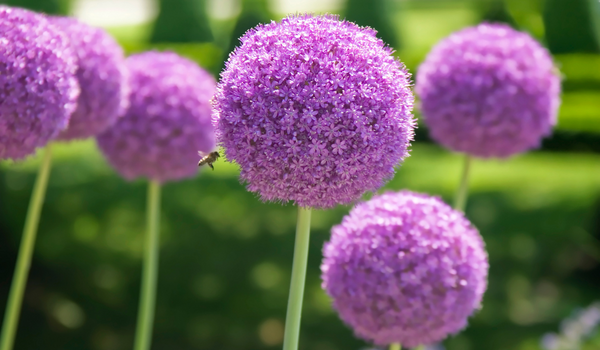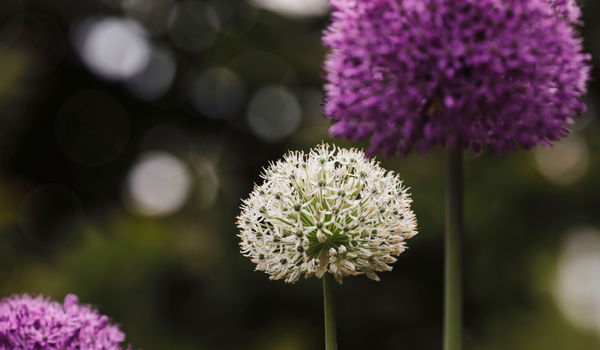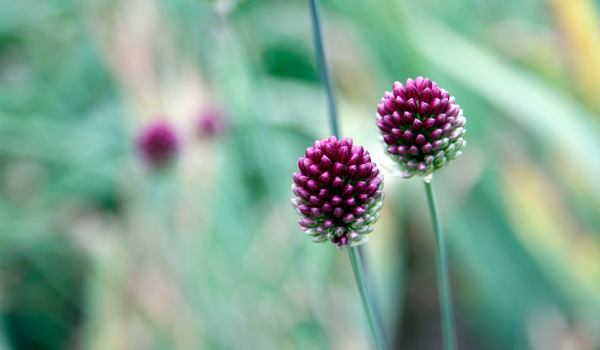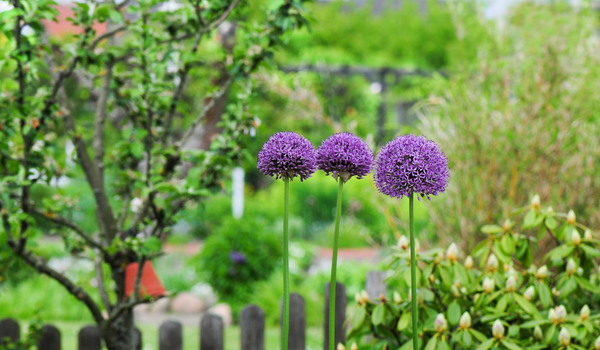How to care for Alliums? - The ultimate caring guide for Alliums
Dive into the world of Alliums and discover how to make your garden burst with vibrant colors and unique charm. In this article, we'll walk you through everything you need to know, from planting and maintenance tips to troubleshooting common issues. Whether you're a seasoned gardener or just starting your green journey, this blog is your go-to resource for nurturing these captivating plants.
Also, check out our other articles on how to plant and grow your Alliums. Let’s go!
Cultivating bigger blooms
To ensure your Alliums produce larger and more vibrant blooms, follow these key steps:
- First, select a well-draining location with full sun exposure, as Alliums thrive in these conditions.
- Next, when planting, ensure the bulbs are buried at the right depth, usually about 3 times the bulb's height.
- Additionally, enrich the soil with compost or organic matter to provide essential nutrients. Water your Alliums consistently, especially during their active growth phase, but avoid waterlogging. To encourage larger blooms, consider a low-nitrogen fertilizer, as excess nitrogen can lead to excessive foliage growth at the expense of flowers.
- Finally, deadhead spent blooms promptly to redirect energy into producing more substantial flowers in the future.

Watering Alliums: finding the right balance
Watering Alliums daily is not recommended, as they thrive in well-drained soil. These stunning flowering bulbs prefer a balanced moisture level. Overwatering can lead to root rot, which can be fatal for the plant. Instead, water them moderately, allowing the soil to dry slightly between waterings. Generally, one to two inches of water per week is sufficient, but adjust this based on local climate conditions. It's essential to monitor soil moisture and ensure good drainage to prevent standing water.
Pinching Alliums for optimal growth
Alliums should ideally be pinched when they reach a height of around 4 to 6 inches (10 to 15 centimeters). This practice, known as pinching, involves removing the top portion of the young Allium plant to encourage bushier growth and more robust blooms later in the season. By pinching them at this height, you promote the development of multiple flower stems and prevent them from becoming too leggy. Timing is crucial, so keep a close eye on your Alliums as they emerge in spring, and when they hit that 4 to 6-inch mark, gently pinch off the top growth for a fuller and more vibrant display come summer.
To stake or not to stake
Alliums, also known as ornamental onions, display a wide range of heights depending on the specific variety. Typically, these elegant flowering bulbs can grow anywhere from 6 inches to a towering 4 feet tall. The height largely hinges on the type of Allium you choose to cultivate, with smaller species like Allium moly and Allium oreophilum on the shorter end of the spectrum, while giants like Allium giganteum can reach impressive heights.
Whether or not you should stake your Alliums largely depends on their height and your local weather conditions. Taller varieties may benefit from staking to prevent toppling over, especially in windy areas or if your soil isn't particularly sturdy. Gardeners often use discreet stakes or rings to provide support, ensuring that your Alliums stand tall and proud, making a striking statement in your garden.

The perfect fertilizer recipe for Alliums
The best fertilizer for Alliums is a well-balanced, slow-release fertilizer with an NPK ratio (nitrogen, phosphorus, and potassium) of approximately 10-10-10 or 5-10-10. These ratios ensure healthy growth, vibrant blooms, and strong root development. Organic options like compost or well-rotted manure can also be beneficial, enriching the soil with essential nutrients. It's crucial to apply the fertilizer in early spring when Alliums are actively growing, typically before they start blooming. Be cautious not to over-fertilize, as excessive nutrients may lead to floppy stems. Regular watering and mulching can complement your fertilization regimen for thriving Alliums that grace your garden with their beauty year after year
DIY fertilizer for Allium bulbs
Creating your own homemade fertilizer for flower bulbs is not only cost-effective but also an eco-friendly way to nourish your plants. To make a nutrient-rich blend, start by mixing well-rotted compost with aged manure in a 2:1 ratio, ensuring it's fully decomposed to avoid burning your bulbs. Next, incorporate bone meal or fish meal for essential phosphorus and potassium, providing a balanced diet for your flowers. Additionally, crushed eggshells can supply calcium, essential for bulb development. To enhance microbial activity and improve soil structure, add organic matter like shredded leaves or grass clippings. Finally, water your bulbs generously after applying this homemade fertilizer to kickstart their growth journey.
Mastering the art of dividing Alliums
To successfully divide Alliums, start by selecting mature bulbs that have been growing for at least a few years. The best time to divide them is in the fall when the foliage begins to wither. Gently dig up the entire clump, being careful not to damage the bulbs. Shake off excess soil and separate the individual bulbs from each other, ensuring that each division has its own roots and shoots. You can use your hands or a clean, sharp knife to separate them. Replant the divisions at the same depth as they were originally, spacing them a few inches apart, and water thoroughly. This process not only rejuvenates your Alliums but also allows you to propagate and expand your beautiful Allium garden.

What happens if you don’t divide Alliums?
If you don't divide Alliums, these captivating flowering bulbs may face several challenges. Over time, Alliums tend to form dense clumps, resulting in overcrowded conditions that can impact their overall health and blooming performance. Without division, competition for nutrients and space can lead to smaller blooms and reduced flower production. Additionally, overcrowded Alliums are more susceptible to diseases and pests due to poor air circulation. To maintain the vitality and vigor of your Alliums, it's essential to divide them every few years in late summer or early fall. This process not only rejuvenates the bulbs but also ensures a breathtaking display of their distinctive globe-like blossoms in your garden.
Post-bloom care for Alliums
After the stunning bloom of your Alliums has faded, it's essential to follow some post-flowering care steps to ensure their continued vitality. Once the flowers have withered and turned brown, carefully trim the flower stalks, but leave the foliage intact. This greenery is crucial for photosynthesis and energy storage for next year's blooms. Resist the urge to cut it back prematurely. Over the summer, continue to water your Alliums as needed, allowing the foliage to die back naturally. In late summer or early fall, when the foliage has turned completely brown, you can then trim it back to ground level. Proper care will help your Alliums thrive and return with their blossoms year after year, enhancing your garden's beauty.
Winterizing Alliums: can you leave them in the ground?
Alliums are generally hardy and can be left in the ground year-round to overwinter in most climates. These bulbs are known for their resilience, enduring cold winter temperatures and emerging anew each spring. However, it's important to consider your specific location and local climate conditions. In colder regions, providing a layer of mulch can offer extra protection from extreme frost. Additionally, some Allium varieties may benefit from division every few years to maintain their vigor.

Do Alliums come back every year?
Alliums are known for their reliability in returning year after year. These perennial plants belong to the onion family and are prized for their stunning globe-shaped blooms. One of the appealing features of Alliums is their ability to return annually. Once you plant these bulbs in well-drained soil and provide them with the right sunlight and care, they'll grace your garden with their vibrant colors and unique shapes year after year. While some varieties may self-sow and produce new bulbs, most Alliums will reliably re-emerge each spring, making them a popular choice for perennial flower enthusiasts and a delightful addition to any garden landscape.
If you're interested in planting tips, don’t miss our guide on how to grow alliums.
Timing is everything: when to cut back alliums?
Alliums should be pruned or cut back after they have fully bloomed and the flowers begin to fade, typically in late spring to early summer. To maintain the aesthetic appeal of your garden and encourage healthy growth for the next season, it's advisable to trim the spent flower heads down to the base of the stem. However, it's essential to leave the foliage intact until it turns yellow and withers, as this allows the plant to gather energy for next year's growth.
For a step-by-step guide, learn how to plant alliums the right way. For a wide selection of beautiful varieties, explore our collection of allium bulbs.
Share
